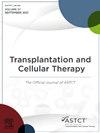TCRα/ß Depleted Mobilized Pbscs without Calcineurin Inhibitors in Patients with Fanconi Anemia
IF 3.6
3区 医学
Q2 HEMATOLOGY
引用次数: 0
Abstract
Background
We performed a single center phase II prospective clinical trial (NCT03579875) to test the hypothesis that TCRα/ß depletion would sufficiently deplete GVHD causing α/ß T cells to eliminate the need for prolonged immunosuppression after PBSC transplantation in patients with FA.
Methods
Patients received conditioning regimen (MacMillan, Blood 2015) with fludarabine, cyclophosphamide and methylprednisolone alone if the patient had marrow failure only and an HLA matched sibling donor (n=2), or with total body irradiation with thymic shielding (n=12) or busulfan (n=17) if there was clonal disease, or if a haploidentical related or HLA matched or mismatched unrelated donor. All but the first patient received one dose of rituximab on day-1 for B cell depletion. Mycophenolate mofetil was given after transplant if the TCRα/ß dose ≥2 × 105 TCR α/β T cells/kg recipient (n=4). Mass cytometry (CyTOF) studies included targeting markers for delineating naïve, effector and effector memory CD4 cells and naïve, stem memory, central memory and effector memory CD8 cells, as well as T regulatory, B and γδ T cell subpopulations.
Results
31 patients with FA, median 9.5 years (range 1.7-43.8) were enrolled. Patients had marrow failure (n=18), MDS (n=4), relapsed MDS (n=1), APML (n=1), ALL (n=1), immune deficiency (n=1), BRCA2 with clonal abnormality (n=2) or pre-emptively for BRCA2 (n=3), with 2 patients having had a prior transplant. Neutrophil engraftment occurred in all patients, median 9 days (Figure A). Platelet recovery occurred in 30 patients, median 15 days. To date, 3 patients developed grade II-IV acute GVHD. No patient has developed chronic GVHD requiring systemic therapy (Figure B). Probability of survival at 2 years is 90%, including 5/6 BRCA2 patients and all 7 adult patients (Figure C).
By 1 year, only 6 patients developed viral infections requiring systemic therapy. Immune recovery in 15 patients was compared to 10 historical FA patients similarly transplanted except for GVHD prophylaxis (TCD by CD34+ selection with calcineurin inhibitor, CNI). Significant finding were: lower proportions of total CD4+ cells (43.0% vs 76.7%, p <0.0002), and memory Tregs (4.8% vs 14.6%, p<0.01), and higher proportions of γδ T cells (30.8% vs 4.8%, p<0.0003) in recipients of TCRα/ß PBSC at day 28. Analysis of γδ T cell proportions at 6 months (16.2% vs 3.2%, p=0.0106; TCRa/bPBSC vs. CD34 selection) indicated that TCRα/ß depletion resulted in a lasting immune imprint, underpinning the differences in reconstitution between these two transplant methodologies (Figure D).
Conclusions
TCRα/ß depleted PBSC transplantation without CNI results in excellent engraftment, minimal GVHD, few viral infections and excellent survival in FA patients with promising outcomes in those with hematologic malignancy, biallelic BRCA2 genotype and older age who historically often did poorly.
无钙调磷酸酶抑制剂的范可尼贫血患者TCRα/ß耗尽动员Pbscs
我们进行了一项单中心II期前瞻性临床试验(NCT03579875),以验证TCRα/ß消耗可以充分消耗GVHD引起的α/ß T细胞,从而消除FA患者PBSC移植后长期免疫抑制的需要。方法仅骨髓衰竭且有HLA匹配的兄弟姐妹供者(n=2)的患者接受氟达拉滨、环磷酰胺和甲基强的松龙单独治疗方案(MacMillan, Blood 2015),有克隆性疾病的患者接受胸腺屏蔽的全身照射(n=12)或有单倍体相同的亲属或HLA匹配或不匹配的非亲属供者(n=17)。除第一位患者外,所有患者均在第1天接受一剂利妥昔单抗治疗B细胞衰竭。移植后给予霉酚酸酯,如果TCRα/ β剂量≥2 × 105个TCRα/ β T细胞/kg受体(n=4)。细胞计数(CyTOF)研究包括靶向标记物,用于描述naïve、效应记忆和效应记忆CD4细胞和naïve、干细胞记忆、中枢记忆和效应记忆CD8细胞,以及T调节、B和γδ T细胞亚群。结果31例FA患者入组,中位年龄9.5年(范围1.7-43.8)。患者有骨髓衰竭(n=18), MDS (n=4),复发MDS (n=1), APML (n=1), ALL (n=1),免疫缺陷(n=1), BRCA2克隆异常(n=2)或BRCA2先发制人(n=3),其中2例患者有移植史。所有患者均出现中性粒细胞植入,中位时间为9天(图A)。30例患者出现血小板恢复,中位时间为15天。迄今为止,有3例患者发展为II-IV级急性GVHD。没有患者发展为需要全身治疗的慢性GVHD(图B)。2年生存率为90%,包括5/6 BRCA2患者和所有7名成人患者(图C)。到1年,只有6名患者发生病毒感染,需要全身治疗。将15例患者的免疫恢复情况与10例除GVHD预防外类似移植的FA患者进行比较(通过CD34+选择钙调神经磷酸酶抑制剂,CNI进行TCD)。显著的发现是:在第28天,TCRα/ß PBSC受体的总CD4+细胞比例(43.0%比76.7%,p< 0.0002)和记忆treg(4.8%比14.6%,p<0.01)较低,γδ T细胞比例(30.8%比4.8%,p<0.0003)较高。6个月时γδ T细胞比例分析(16.2% vs 3.2%, p=0.0106;TCRa/bPBSC与CD34选择)表明,TCRa/bPBSC缺失导致了持久的免疫印记,支持了这两种移植方法之间的重建差异(图D)。结论stcra / β缺失的PBSC移植无CNI可获得良好的植入,最小的GVHD,很少的病毒感染和良好的生存率,对于血液学恶性肿瘤患者具有良好的预后。双等位基因BRCA2基因型和历史上经常表现不佳的老年人。
本文章由计算机程序翻译,如有差异,请以英文原文为准。
求助全文
约1分钟内获得全文
求助全文
来源期刊

Transplantation and Cellular Therapy
Medicine-Hematology
CiteScore
7.00
自引率
15.60%
发文量
1061
审稿时长
51 days
 求助内容:
求助内容: 应助结果提醒方式:
应助结果提醒方式:


